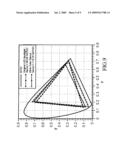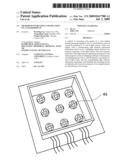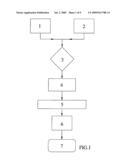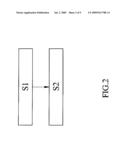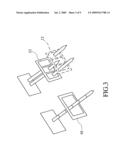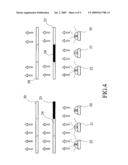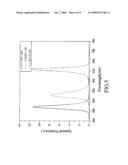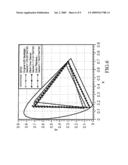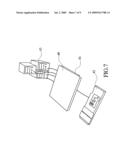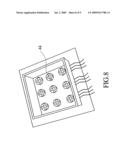Patent application title: METHOD OF INCREASING COLOR GAMUT OF A COLOR DISPLAY
Inventors:
Wei-Ping Lin (Taipei City, TW)
Tsung-Hsun Yang (Hsinchu, TW)
Ching-Cherng Sun (Taoyuan County, TW)
Ching-Cherng Sun (Taoyuan County, TW)
Assignees:
NATIONAL CENTRAL UNIVERSITY
IPC8 Class: AG09G510FI
USPC Class:
345690
Class name: Computer graphics processing and selective visual display systems display driving control circuitry intensity or color driving control (e.g., gray scale)
Publication date: 2009-07-02
Patent application number: 20090167788
lor gamut of a color display includes grouping
subpixels of R, G, and B primary colors of a pixel by grouping R, G, and
B light sources of the color display with a corresponding light intensity
adjustment mechanism based on an overlapping degree between two response
spectrums of the light sources such that response spectrums of the light
intensity adjustment mechanism of the same group have a least overlapping
with that of other groups; and enabling groups of R, G, and B subpixels,
activating R, G, and B light source and the corresponding light intensity
adjustment mechanism, and disabling the remaining groups of subpixels all
by turns for creating a vivid complete picture by time division
color-mixingClaims:
1. A method of increasing color gamut of a color display device,
comprising the steps of:(i) grouping subpixels of red (R), green (G), and
blue (B) primary colors of a pixel by grouping light sources of different
primary colors of the color display device with a corresponding light
intensity adjustment mechanism based on an overlapping degree between two
response spectrums of the light sources such that response spectrums of
the light intensity adjustment mechanism of the same group have a least
overlapping with that of other groups;(ii) enabling a first group of
subpixels of a first primary color at a first time frame, activating a
first primary color light source to emit first primary color light and
the corresponding light intensity adjustment mechanism, and disabling the
remaining groups of subpixels of different primary colors;(iii) enabling
a second group of subpixels of a second primary color at a second time
frame, activating a second primary color light source to emit second
primary color light and the corresponding light intensity adjustment
mechanism, and disabling the remaining groups of subpixels of different
primary colors; and(iv) enabling a third group of subpixels of a third
primary color at a third time frame, activating a third primary color
light source to emit third primary color light and the corresponding
light intensity adjustment mechanism, and disabling the remaining groups
of subpixels of different primary colors for creating a complete picture
by time division color-mixing.
2. The method of claim 1, wherein the light intensity adjustment mechanism is capable of adjusting light intensity of each primary color light source.
3. The method of claim 1, wherein the light intensity adjustment mechanism includes liquid crystals, a polarizer, and a color filter.
4. The method of claim 1, wherein each subpixel includes an R-G subpixel and an R-B subpixel.
5. The method of claim 4, wherein the light sources of different primary colors are red (R), green (G), and blue (B) LEDs, and wherein backlight of the red LED corresponding to the R-G subpixel or the R-B subpixel is not processed.
6. The method of claim 1, wherein a first pixel corresponding to B light is disabled when backlight of the G light source passes through a color filter (CF), and a second pixel corresponding to G light is disabled when backlight of the B light source passes through the CF.
7. The method of claim 1, wherein backlight flash time of the B and the G light sources are shorter than time required for the human eyes to perceive.Description:
BACKGROUND OF THE INVENTION
[0001]1. Field of the Invention
[0002]The invention relates to methods of increasing color gamut of color display, and more particularly to a backlight driving method which can increase color gamut of a color display so as to make picture shown on the display to be more vivid.
[0003]2. Description of Related Art
[0004]Typically, a light-emitting diode (LED) may be employed to illuminate an indicator lamp, a traffic light, a floodlight, a vehicle light, or a backlight module of a display.
[0005]Generally, red (R), green (G), and blue (B) single chips are incorporated into an LED or R, G, and B LEDs are combined to emit white light. Both are widely employed as backlight source by the industry, i.e., LED as the backlight source. This has many advantages including no energy consumption resulted from the conversion of fluorescence powder, and color temperature being adapted to change by controlling light intensity of each of R, B, and B LEDs.
[0006]Following is a comparison between RGB LED backlight source and a conventional cold cathode fluorescent lamp (CCFL) backlight source with respect to color. For CCFL backlight source, it is high in the performance of blue color but low in the performance of red and green colors. Hence, such type of LCD (liquid crystal display) display tends to emit blue light. As a result, color gamut of a CCFL backlight source is only about 70% of that defined by color television broadcast standard published by National Television Standards Committee (NTSC). Color gamut of a newly developed CCFL is only about 95% of that defined by NTSC. But theoretically LED backlight source can have a color gamut more than 120% NTSC by mixing RGB lights. This is much better than 70%-95% of that of CCFL. Hence, many major display device manufacturers make every effort to develop a display employing three-color LEDs as the backlight source.
[0007]In fact, a transmission spectrum of blue wavelength largely overlaps that of green wavelength in a typical color filter (CF). Hence, blue light emitted by an LED backlight passing through a CF always leaves from a green CF. Similarly, green light emitted by an LED backlight passing through a CF always leaves from a blue CF. Hence, purity of three primary colors of light emitted by a display is decreased significantly. As a result, a color gamut of the display is decreased undesirably. This is an important technical issue to be addressed when considering the high color saturation requirement of a display.
[0008]For solving the problem of low color saturation of a display, Yoichi Taira et al proposed a brand new structure of color display by introducing a color filterless in 2003. In this proposal, LEDs in the backlight source are employed to adjust and control color of a display. This technique was first disclosed by Korea's Samsung Company in Yokohama show in October 2005. In addition, Taiwan's Chunghwa Picture Tubes Company exhibited a 32'' color liquid crystal display (LCD) display with color filterless LEDs in June 2006.
[0009]Color filterless display is a display device employs no color filter. In the technical field, color mixing is achieved by rather than by spatial color-mixing. This has the benefit of producing many different colors in pixels on a display by only employing a small number of light sources of primary color. Spatial color-mixing means that people can see different colors on a color display depending on pixels. A pixel is comprised of subpixels of primary colors (e.g., red, blue and green color subpixels). These subpixels are shown in a visible frequency range smaller than that people can see so as to cause the effect of color-mixing to occur. if employing temporal color-mixing, which can make each primary color light (such as red, blue or green color) of the display to switch sequentially quickly in the same space. If the switching speed is faster than the time needed for a person to distinguish different colors by the eyes, the effect of temporal color-mixing can be achieved because of the persistence of vision. A new structure of color display of temporal color-mixing employs multicolor LEDs (such as red, green and blue LEDs) as backlight source. These multicolor LEDs are adapted to flash at different time intervals. Next, liquid crystal controls brightness of each color so as to show a desired color in a picture.
[0010]The above description regarding a color LCD display with color filterless LEDs employing temporal color-mixing demonstrates many advantages including no CF and increased light efficiency. Backlight source is achieved by each color LED flashes at different time intervals. Power consumption is also decreased. Thus the problem of insufficient heat removal of LED backlight is easily solved.
[0011]However, a required condition of manufacturing a color LCD display with color filterless LEDs is that liquid crystal itself should have very quick response time so as to match with the speed threshold of temporal color-mixing which is very difficult to achieve in view of current technology. Besides, in a technology of employing a six-color LED, the complexity of color adjustment increases significantly. However, so far as the inventor is aware, there are no disclosures addressing above problems experienced by color displays.
[0012]The closest prior art to the invention described hereinafter is U.S. Pat. No. 7,164,454.
SUMMARY OF THE INVENTION
[0013]It is therefore one object of the invention to provide a method of increasing color gamut of a color display device, comprising the steps of (i) grouping subpixels of red (R), green (G), and blue (B) primary colors of a pixel by grouping light sources of different primary colors of the color display device with a corresponding light intensity adjustment mechanism based on an overlapping degree between two response spectrums of the light sources such that response spectrums of the light intensity adjustment mechanism of the same group have a least overlapping with that of other groups; (ii) enabling a first group of subpixels of a first primary color at a first time frame, activating a first primary color light source to emit first primary color light and the corresponding light intensity adjustment mechanism, and disabling the remaining groups of subpixels of different primary colors; (iii) enabling a second group of subpixels of a second primary color at a second time frame, activating a second primary color light source to emit second primary color light and the corresponding light intensity adjustment mechanism, and disabling the remaining groups of subpixels of different primary colors; and (iv) enabling a third group of subpixels of a third primary color at a third time frame, activating a third primary color light source to emit third primary color light and the corresponding light intensity adjustment mechanism, and disabling the remaining groups of subpixels of different primary colors for creating a complete picture by time division color-mixing.
[0014]The above and other objects, features and advantages of the invention will become apparent from the following detailed description taken with the accompanying drawings.
BRIEF DESCRIPTION OF THE DRAWINGS
[0015]FIG. 1 is a flowchart depicting a method of increasing color gamut of a color display according to the invention;
[0016]FIG. 2 is a view illustrating two steps of the method according to the invention;
[0017]FIG. 3 is a schematic view of a pixel employed by the method according to the invention;
[0018]FIG. 4 is a schematic view illustrating B and G backlight LEDs according to the invention flashing sequentially at different time intervals;
[0019]FIG. 5 plots wavelength versus spectral power for R, G, and B LEDs according to the invention;
[0020]FIG. 6 is a chromaticity diagram of NTSC, original LED backlight, wide color gamut, and color filterless for comparison according to the invention;
[0021]FIG. 7 is a schematic view showing an apparatus constructed according to the method of the invention;
[0022]FIG. 8 is a schematic view showing the structure of an LED backlight source according to the invention; and
[0023]FIG. 9 is a chromaticity diagram of the entire range of possible chromaticities, NTSC, original LED backlight, and wide color gamut for comparison according to the invention.
DETAILED DESCRIPTION OF THE PREFERRED EMBODIMENTS
[0024]The invention is directed to a method of increasing color gamut of a color display as illustrated in FIGS. 1 and 2. The method comprises following steps:
[0025]Step S1 involves grouping subpixels of different (three) primary colors of a pixel. In detail, grouping (numeral 3 in FIG. 1) light sources of respective primary colors of a color display with a corresponding light intensity adjustment mechanism (numeral 2 in FIG. 1) based on an overlapping degree between two response spectrums (numeral 1 in FIG. 1) of the light sources. As such, response spectrums of light intensity adjustment mechanism of the same group have a least overlapping with that of other groups. Primary color lights of each group are comprised of subpixels of the same primary color.
[0026]The light intensity adjustment mechanism of each primary color of the color display comprises a plurality of components which have the capability of adjusting light intensity of each primary color light of the color display. These components include resistors, liquid crystals, and polarizers in an LCD display device.
[0027]Step S2 involves enabling subpixels by turns. In detail, only one group of subpixels of primary color is enabled at one time frame based on the above grouping of subpixels of different primary colors (numeral 4 in FIG. 1). That is, a primary color light source is activated to emit the primary color light and the corresponding light intensity adjustment mechanism is activated. Other groups of subpixels of different primary colors are disabled at the same time. In a next time period, another group of subpixels of different primary color is enabled with the remaining groups of subpixels of different primary colors being disabled (numeral 5 in FIG. 1). That is, enabling of the groups of subpixels of different primary colors is done by turns. Finally, a complete picture is created (numeral 7 in FIG. 1) by time division color-mixing (numeral 6 in FIG. 1).
[0028]Referring to FIGS. 3 and 4, the method of the invention will be further illustrated by discussing a preferred embodiment below.
[0029]Each pixel 10 provided with R, G, B primary colors is segmented into two subpixels including an R-G subpixel 11 and an R-B subpixel 12. As such, a liquid crystal pixel 23 corresponding to blue (B) light is disabled when backlight of a green (G) light source 21 passes through a color filter (CF) 30. Likewise, a liquid crystal pixel 24 corresponding to a green light is disabled when backlight of a blue light source 20 passes through the CF 30. Hence, backlight of blue light source 20 and backlight of green light source 21 flash alternately at different time intervals in order to prevent blue and green pixels from leaking light each other. Backlight of red (R) light source 22 corresponding to the R-G subpixel 11 or the R-B subpixel 12 is not processed because spectrum overlapping is minimal. Moreover, making backlight flash time of blue and green light sources 20 and 22 shorter than time needed for the eyes to perceive will cause the flashing to be unfound by the eyes because of the persistence of vision. As a result, the effect of each color being created by mixing by each pixel is created.
[0030]The blue light source 20 comprises a blue LED, the green light source 21 comprises a green LED, and the red light source 22 comprises a red LED respectively.
[0031]When backlight of green light source 21 flashes, the liquid crystal pixel 23 corresponding to blue light is disabled. Thus, backlight leakage from blue light source 20 is prohibited when a green pixel is enabled. To the contrary, in a next time frame backlight of blue light source 20 is enabled and the liquid crystal pixel 24 corresponding to green light is disabled. Hence, backlight leakage from green light source 21 is prohibited when a blue pixel is enabled. As long as making backlight flash time of blue and green light sources 20 and 22 shorter than time needed for the eyes to perceive will cause the flashing to be unfound by the eyes. As a result, the effect of each color being created by mixing by each pixel is created. In such a manner, purity of three primary colors of the display increases significantly, thereby greatly increasing the color gamut of display.
[0032]The invention is featured by increasing color gamut without changing many mechanisms of an existing LED backlight display, not requiring a very fast liquid crystal response time, and simple manufacturing processes.
[0033]In the invention, LEDs are employed as backlight sources in an experimental backlight module. Specifications and features of the backlight module are shown in the following Table 1.
TABLE-US-00001 TABLE 1 Specifications of a three-color LED Width Dominant of Half-Height LED Model Color Wavelength Wavelength Luxeon ® Emitter LXHL-PD01 Red 635 nm 20 nm Luxeon ® Emitter LXHL-PM01 Green 518 nm 33 nm Luxeon ® Emitter LXHL-PB01 Blue 458 nm 22 nm
[0034]An integrating sphere photometer is employed to measure the spectral power of a three-color LED as shown in FIG. 5. Initial theoretical estimation of the three-color LED backlight is made in order to show the current LED backlight structure and technology about increasing color gamut backlight and show differences of the color filterless LCD in the color gamut. For example, as shown in FIG. 6, it is apparent that gamut of primary LED backlight is 100.28% NTSC and gamut of increased color gamut according to the invention is 117.41% NTSC which is higher than the primary color gamut by approximately 17% NTSC. LCD color gamut of color filterless is 119.02% NTSC in which difference with the gamut of increased color gamut is about 1.5%.
[0035]In view of above, it is found that in the technology of increased color gamut backlight, color gamut of display can be increased significantly. The color gamut has a range about the same as the increasing color gamut of a three-color LED. Finally, there is no need to greatly modify the construction of display.
[0036]An LCD panel and its backlight structure employed by the invention are described by referring to FIGS. 7 and 8. The LCD panel being used is a 19'' LCD manufactured by Samsung Company. Its CCFL backlight source is removed with only a panel 40 being left. A color filter and a diffuser are replaced with a backlight module 41 having LEDs of three primary colors. The backlight module 41 is electrically connected to a panel drive circuit 42 and a power supply 43 respectively (FIG. 7). A backlight source 44 is provided with 3×3 units each having four RGGB LEDs. For making emitted light to be uniform when mixing LED backlight sources, a reflecting diffusion film is adhered on a light emitting hole of each LED.
[0037]Referring to FIG. 9, a chromaticity diagram of the entire range of possible chromaticities, NTSC, original LED backlight, and wide color gamut for comparison according to the invention is shown. The horseshoe shape represents the entire range of possible chromaticities. Gamut area of NTSC is represented by a solid line triangle. Gamut area of original LED backlight is represented by a triangle enclosed by a solid line dotted with spots. Gamut area of wide color gamut is represented by a triangle enclosed by a solid line dotted with squares. It is evident that a color gamut area enclosed by the solid line dotted with squares is larger than that enclosed by solid line dotted with spots. In view of the given data, the color gamut is increased from 99% NTSC to 116.76% NTSC by about 18% NTSC. Thus, its is evident that the color gamut can be increased by taking advantage of the technology of increasing color gamut backlight. As an end, it is possible of making picture seen from a display to be more vivid.
[0038]It is apparent that there is no need to remove CF in the invention. Also, the method is compatible with the existing manufacturing processes. Thus, regardless of which display being used and quick or slow response time of a display, the effect of obtaining each different primary color by mixing by the pixels can be achieved. Further, the color gamut of display is greatly increased. More importantly, there is no requirement for a conventional LCD display device without color filterless to have a sufficiently short response time.
[0039]While the invention herein disclosed has been described by means of specific embodiments, numerous modifications and variations could be made thereto by those skilled in the art without departing from the scope and spirit of the invention set forth in the claims.
Claims:
1. A method of increasing color gamut of a color display device,
comprising the steps of:(i) grouping subpixels of red (R), green (G), and
blue (B) primary colors of a pixel by grouping light sources of different
primary colors of the color display device with a corresponding light
intensity adjustment mechanism based on an overlapping degree between two
response spectrums of the light sources such that response spectrums of
the light intensity adjustment mechanism of the same group have a least
overlapping with that of other groups;(ii) enabling a first group of
subpixels of a first primary color at a first time frame, activating a
first primary color light source to emit first primary color light and
the corresponding light intensity adjustment mechanism, and disabling the
remaining groups of subpixels of different primary colors;(iii) enabling
a second group of subpixels of a second primary color at a second time
frame, activating a second primary color light source to emit second
primary color light and the corresponding light intensity adjustment
mechanism, and disabling the remaining groups of subpixels of different
primary colors; and(iv) enabling a third group of subpixels of a third
primary color at a third time frame, activating a third primary color
light source to emit third primary color light and the corresponding
light intensity adjustment mechanism, and disabling the remaining groups
of subpixels of different primary colors for creating a complete picture
by time division color-mixing.
2. The method of claim 1, wherein the light intensity adjustment mechanism is capable of adjusting light intensity of each primary color light source.
3. The method of claim 1, wherein the light intensity adjustment mechanism includes liquid crystals, a polarizer, and a color filter.
4. The method of claim 1, wherein each subpixel includes an R-G subpixel and an R-B subpixel.
5. The method of claim 4, wherein the light sources of different primary colors are red (R), green (G), and blue (B) LEDs, and wherein backlight of the red LED corresponding to the R-G subpixel or the R-B subpixel is not processed.
6. The method of claim 1, wherein a first pixel corresponding to B light is disabled when backlight of the G light source passes through a color filter (CF), and a second pixel corresponding to G light is disabled when backlight of the B light source passes through the CF.
7. The method of claim 1, wherein backlight flash time of the B and the G light sources are shorter than time required for the human eyes to perceive.
Description:
BACKGROUND OF THE INVENTION
[0001]1. Field of the Invention
[0002]The invention relates to methods of increasing color gamut of color display, and more particularly to a backlight driving method which can increase color gamut of a color display so as to make picture shown on the display to be more vivid.
[0003]2. Description of Related Art
[0004]Typically, a light-emitting diode (LED) may be employed to illuminate an indicator lamp, a traffic light, a floodlight, a vehicle light, or a backlight module of a display.
[0005]Generally, red (R), green (G), and blue (B) single chips are incorporated into an LED or R, G, and B LEDs are combined to emit white light. Both are widely employed as backlight source by the industry, i.e., LED as the backlight source. This has many advantages including no energy consumption resulted from the conversion of fluorescence powder, and color temperature being adapted to change by controlling light intensity of each of R, B, and B LEDs.
[0006]Following is a comparison between RGB LED backlight source and a conventional cold cathode fluorescent lamp (CCFL) backlight source with respect to color. For CCFL backlight source, it is high in the performance of blue color but low in the performance of red and green colors. Hence, such type of LCD (liquid crystal display) display tends to emit blue light. As a result, color gamut of a CCFL backlight source is only about 70% of that defined by color television broadcast standard published by National Television Standards Committee (NTSC). Color gamut of a newly developed CCFL is only about 95% of that defined by NTSC. But theoretically LED backlight source can have a color gamut more than 120% NTSC by mixing RGB lights. This is much better than 70%-95% of that of CCFL. Hence, many major display device manufacturers make every effort to develop a display employing three-color LEDs as the backlight source.
[0007]In fact, a transmission spectrum of blue wavelength largely overlaps that of green wavelength in a typical color filter (CF). Hence, blue light emitted by an LED backlight passing through a CF always leaves from a green CF. Similarly, green light emitted by an LED backlight passing through a CF always leaves from a blue CF. Hence, purity of three primary colors of light emitted by a display is decreased significantly. As a result, a color gamut of the display is decreased undesirably. This is an important technical issue to be addressed when considering the high color saturation requirement of a display.
[0008]For solving the problem of low color saturation of a display, Yoichi Taira et al proposed a brand new structure of color display by introducing a color filterless in 2003. In this proposal, LEDs in the backlight source are employed to adjust and control color of a display. This technique was first disclosed by Korea's Samsung Company in Yokohama show in October 2005. In addition, Taiwan's Chunghwa Picture Tubes Company exhibited a 32'' color liquid crystal display (LCD) display with color filterless LEDs in June 2006.
[0009]Color filterless display is a display device employs no color filter. In the technical field, color mixing is achieved by rather than by spatial color-mixing. This has the benefit of producing many different colors in pixels on a display by only employing a small number of light sources of primary color. Spatial color-mixing means that people can see different colors on a color display depending on pixels. A pixel is comprised of subpixels of primary colors (e.g., red, blue and green color subpixels). These subpixels are shown in a visible frequency range smaller than that people can see so as to cause the effect of color-mixing to occur. if employing temporal color-mixing, which can make each primary color light (such as red, blue or green color) of the display to switch sequentially quickly in the same space. If the switching speed is faster than the time needed for a person to distinguish different colors by the eyes, the effect of temporal color-mixing can be achieved because of the persistence of vision. A new structure of color display of temporal color-mixing employs multicolor LEDs (such as red, green and blue LEDs) as backlight source. These multicolor LEDs are adapted to flash at different time intervals. Next, liquid crystal controls brightness of each color so as to show a desired color in a picture.
[0010]The above description regarding a color LCD display with color filterless LEDs employing temporal color-mixing demonstrates many advantages including no CF and increased light efficiency. Backlight source is achieved by each color LED flashes at different time intervals. Power consumption is also decreased. Thus the problem of insufficient heat removal of LED backlight is easily solved.
[0011]However, a required condition of manufacturing a color LCD display with color filterless LEDs is that liquid crystal itself should have very quick response time so as to match with the speed threshold of temporal color-mixing which is very difficult to achieve in view of current technology. Besides, in a technology of employing a six-color LED, the complexity of color adjustment increases significantly. However, so far as the inventor is aware, there are no disclosures addressing above problems experienced by color displays.
[0012]The closest prior art to the invention described hereinafter is U.S. Pat. No. 7,164,454.
SUMMARY OF THE INVENTION
[0013]It is therefore one object of the invention to provide a method of increasing color gamut of a color display device, comprising the steps of (i) grouping subpixels of red (R), green (G), and blue (B) primary colors of a pixel by grouping light sources of different primary colors of the color display device with a corresponding light intensity adjustment mechanism based on an overlapping degree between two response spectrums of the light sources such that response spectrums of the light intensity adjustment mechanism of the same group have a least overlapping with that of other groups; (ii) enabling a first group of subpixels of a first primary color at a first time frame, activating a first primary color light source to emit first primary color light and the corresponding light intensity adjustment mechanism, and disabling the remaining groups of subpixels of different primary colors; (iii) enabling a second group of subpixels of a second primary color at a second time frame, activating a second primary color light source to emit second primary color light and the corresponding light intensity adjustment mechanism, and disabling the remaining groups of subpixels of different primary colors; and (iv) enabling a third group of subpixels of a third primary color at a third time frame, activating a third primary color light source to emit third primary color light and the corresponding light intensity adjustment mechanism, and disabling the remaining groups of subpixels of different primary colors for creating a complete picture by time division color-mixing.
[0014]The above and other objects, features and advantages of the invention will become apparent from the following detailed description taken with the accompanying drawings.
BRIEF DESCRIPTION OF THE DRAWINGS
[0015]FIG. 1 is a flowchart depicting a method of increasing color gamut of a color display according to the invention;
[0016]FIG. 2 is a view illustrating two steps of the method according to the invention;
[0017]FIG. 3 is a schematic view of a pixel employed by the method according to the invention;
[0018]FIG. 4 is a schematic view illustrating B and G backlight LEDs according to the invention flashing sequentially at different time intervals;
[0019]FIG. 5 plots wavelength versus spectral power for R, G, and B LEDs according to the invention;
[0020]FIG. 6 is a chromaticity diagram of NTSC, original LED backlight, wide color gamut, and color filterless for comparison according to the invention;
[0021]FIG. 7 is a schematic view showing an apparatus constructed according to the method of the invention;
[0022]FIG. 8 is a schematic view showing the structure of an LED backlight source according to the invention; and
[0023]FIG. 9 is a chromaticity diagram of the entire range of possible chromaticities, NTSC, original LED backlight, and wide color gamut for comparison according to the invention.
DETAILED DESCRIPTION OF THE PREFERRED EMBODIMENTS
[0024]The invention is directed to a method of increasing color gamut of a color display as illustrated in FIGS. 1 and 2. The method comprises following steps:
[0025]Step S1 involves grouping subpixels of different (three) primary colors of a pixel. In detail, grouping (numeral 3 in FIG. 1) light sources of respective primary colors of a color display with a corresponding light intensity adjustment mechanism (numeral 2 in FIG. 1) based on an overlapping degree between two response spectrums (numeral 1 in FIG. 1) of the light sources. As such, response spectrums of light intensity adjustment mechanism of the same group have a least overlapping with that of other groups. Primary color lights of each group are comprised of subpixels of the same primary color.
[0026]The light intensity adjustment mechanism of each primary color of the color display comprises a plurality of components which have the capability of adjusting light intensity of each primary color light of the color display. These components include resistors, liquid crystals, and polarizers in an LCD display device.
[0027]Step S2 involves enabling subpixels by turns. In detail, only one group of subpixels of primary color is enabled at one time frame based on the above grouping of subpixels of different primary colors (numeral 4 in FIG. 1). That is, a primary color light source is activated to emit the primary color light and the corresponding light intensity adjustment mechanism is activated. Other groups of subpixels of different primary colors are disabled at the same time. In a next time period, another group of subpixels of different primary color is enabled with the remaining groups of subpixels of different primary colors being disabled (numeral 5 in FIG. 1). That is, enabling of the groups of subpixels of different primary colors is done by turns. Finally, a complete picture is created (numeral 7 in FIG. 1) by time division color-mixing (numeral 6 in FIG. 1).
[0028]Referring to FIGS. 3 and 4, the method of the invention will be further illustrated by discussing a preferred embodiment below.
[0029]Each pixel 10 provided with R, G, B primary colors is segmented into two subpixels including an R-G subpixel 11 and an R-B subpixel 12. As such, a liquid crystal pixel 23 corresponding to blue (B) light is disabled when backlight of a green (G) light source 21 passes through a color filter (CF) 30. Likewise, a liquid crystal pixel 24 corresponding to a green light is disabled when backlight of a blue light source 20 passes through the CF 30. Hence, backlight of blue light source 20 and backlight of green light source 21 flash alternately at different time intervals in order to prevent blue and green pixels from leaking light each other. Backlight of red (R) light source 22 corresponding to the R-G subpixel 11 or the R-B subpixel 12 is not processed because spectrum overlapping is minimal. Moreover, making backlight flash time of blue and green light sources 20 and 22 shorter than time needed for the eyes to perceive will cause the flashing to be unfound by the eyes because of the persistence of vision. As a result, the effect of each color being created by mixing by each pixel is created.
[0030]The blue light source 20 comprises a blue LED, the green light source 21 comprises a green LED, and the red light source 22 comprises a red LED respectively.
[0031]When backlight of green light source 21 flashes, the liquid crystal pixel 23 corresponding to blue light is disabled. Thus, backlight leakage from blue light source 20 is prohibited when a green pixel is enabled. To the contrary, in a next time frame backlight of blue light source 20 is enabled and the liquid crystal pixel 24 corresponding to green light is disabled. Hence, backlight leakage from green light source 21 is prohibited when a blue pixel is enabled. As long as making backlight flash time of blue and green light sources 20 and 22 shorter than time needed for the eyes to perceive will cause the flashing to be unfound by the eyes. As a result, the effect of each color being created by mixing by each pixel is created. In such a manner, purity of three primary colors of the display increases significantly, thereby greatly increasing the color gamut of display.
[0032]The invention is featured by increasing color gamut without changing many mechanisms of an existing LED backlight display, not requiring a very fast liquid crystal response time, and simple manufacturing processes.
[0033]In the invention, LEDs are employed as backlight sources in an experimental backlight module. Specifications and features of the backlight module are shown in the following Table 1.
TABLE-US-00001 TABLE 1 Specifications of a three-color LED Width Dominant of Half-Height LED Model Color Wavelength Wavelength Luxeon ® Emitter LXHL-PD01 Red 635 nm 20 nm Luxeon ® Emitter LXHL-PM01 Green 518 nm 33 nm Luxeon ® Emitter LXHL-PB01 Blue 458 nm 22 nm
[0034]An integrating sphere photometer is employed to measure the spectral power of a three-color LED as shown in FIG. 5. Initial theoretical estimation of the three-color LED backlight is made in order to show the current LED backlight structure and technology about increasing color gamut backlight and show differences of the color filterless LCD in the color gamut. For example, as shown in FIG. 6, it is apparent that gamut of primary LED backlight is 100.28% NTSC and gamut of increased color gamut according to the invention is 117.41% NTSC which is higher than the primary color gamut by approximately 17% NTSC. LCD color gamut of color filterless is 119.02% NTSC in which difference with the gamut of increased color gamut is about 1.5%.
[0035]In view of above, it is found that in the technology of increased color gamut backlight, color gamut of display can be increased significantly. The color gamut has a range about the same as the increasing color gamut of a three-color LED. Finally, there is no need to greatly modify the construction of display.
[0036]An LCD panel and its backlight structure employed by the invention are described by referring to FIGS. 7 and 8. The LCD panel being used is a 19'' LCD manufactured by Samsung Company. Its CCFL backlight source is removed with only a panel 40 being left. A color filter and a diffuser are replaced with a backlight module 41 having LEDs of three primary colors. The backlight module 41 is electrically connected to a panel drive circuit 42 and a power supply 43 respectively (FIG. 7). A backlight source 44 is provided with 3×3 units each having four RGGB LEDs. For making emitted light to be uniform when mixing LED backlight sources, a reflecting diffusion film is adhered on a light emitting hole of each LED.
[0037]Referring to FIG. 9, a chromaticity diagram of the entire range of possible chromaticities, NTSC, original LED backlight, and wide color gamut for comparison according to the invention is shown. The horseshoe shape represents the entire range of possible chromaticities. Gamut area of NTSC is represented by a solid line triangle. Gamut area of original LED backlight is represented by a triangle enclosed by a solid line dotted with spots. Gamut area of wide color gamut is represented by a triangle enclosed by a solid line dotted with squares. It is evident that a color gamut area enclosed by the solid line dotted with squares is larger than that enclosed by solid line dotted with spots. In view of the given data, the color gamut is increased from 99% NTSC to 116.76% NTSC by about 18% NTSC. Thus, its is evident that the color gamut can be increased by taking advantage of the technology of increasing color gamut backlight. As an end, it is possible of making picture seen from a display to be more vivid.
[0038]It is apparent that there is no need to remove CF in the invention. Also, the method is compatible with the existing manufacturing processes. Thus, regardless of which display being used and quick or slow response time of a display, the effect of obtaining each different primary color by mixing by the pixels can be achieved. Further, the color gamut of display is greatly increased. More importantly, there is no requirement for a conventional LCD display device without color filterless to have a sufficiently short response time.
[0039]While the invention herein disclosed has been described by means of specific embodiments, numerous modifications and variations could be made thereto by those skilled in the art without departing from the scope and spirit of the invention set forth in the claims.
User Contributions:
Comment about this patent or add new information about this topic:

